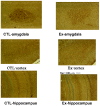Treatment of Alzheimer's disease with anti-homocysteic acid antibody in 3xTg-AD male mice
- PMID: 20098691
- PMCID: PMC2808336
- DOI: 10.1371/journal.pone.0008593
Treatment of Alzheimer's disease with anti-homocysteic acid antibody in 3xTg-AD male mice
Abstract
Alzheimer's disease (AD) is an age-associated progressive neurodegenerative disorder with dementia, the exact pathogenic mechanisms of which remain unknown. We previously reported that homocysteic acid (HA) may be one of the pathological biomarkers in the brain with AD and that the increased levels of HA may induce the accumulation of intraneuronal amyloid-beta (Abeta) peptides. In this study, we further investigated the pathological role of HA in a mouse model of AD. Four-month-old prepathological 3xTg-AD mice exhibited higher levels of HA in the hippocampus than did age-matched nontransgenic mice, suggesting that HA accumulation may precede both Abeta and tau pathologies. We then fed 3-month-old 3xTg-AD mice with vitamin B6-deficient food for 3 weeks to increase the HA levels in the brain. Concomitantly, mice received either saline or anti-HA antibody intraventricularly via a guide cannula every 3 days during the course of the B6-deficient diet. We found that mice that received anti-HA antibody significantly resisted cognitive impairment induced by vitamin B6 deficiency and that AD-related pathological changes in their brains was attenuated compared with the saline-injected control group. A similar neuroprotective effect was observed in 12-month-old 3xTg-AD mice that received anti-HA antibody injections while receiving the regular diet. We conclude that increased brain HA triggers memory impairment and that this condition deteriorates with amyloid and leads to subsequent neurodegeneration in mouse models of AD.
Conflict of interest statement
Figures





References
-
- Hasegawa T. Prolonged stress will induce Alzheimer's disease in elderly people by increased release of homocysteic acid. Medical Hypotheses. 2007;69:1135–1139. - PubMed
-
- Do KQ, Herrling PL, Streit P, Cuenod M. Release of neuroactive substances: homocysteic acid as an endogenous agonist of the NMDA receptor. J Neural Transm. 1988;2(3):185–190. - PubMed
-
- Do KQ, Benz B, Sorg O, Pellerin L, Magistretti PJ. Beta-Adrenergic stimulation promotes homocysteic acid release from astrocyte cultures: evidence for a role of astrocytes in the modulation of synaptic transmission. J Neurochem. 1997;68(6):2386–2394. - PubMed
-
- Lockhart B, Jones C, Cuisinier C, Villain N, Peyroulan D, et al. Inhibition of L-homocysteic acid and buthionine sulphoximine-mediated neurotoxicity in rat embryonic neuronal cultures with α-lipoic acid enantiomers. Brain Research. 2000;855(2):292–297. - PubMed
-
- Folbergrová J, Ješina P, Drahota Z, Haugvicová VL, Vojtíšková A, et al. Mitochondrial complex I inhibition in cerebral cortex of immature rats following homocysteic acid-induced seizures. Experimental Neurology. 2007;204(2):597–609. - PubMed
Publication types
MeSH terms
Substances
LinkOut - more resources
Full Text Sources
Medical
Molecular Biology Databases

